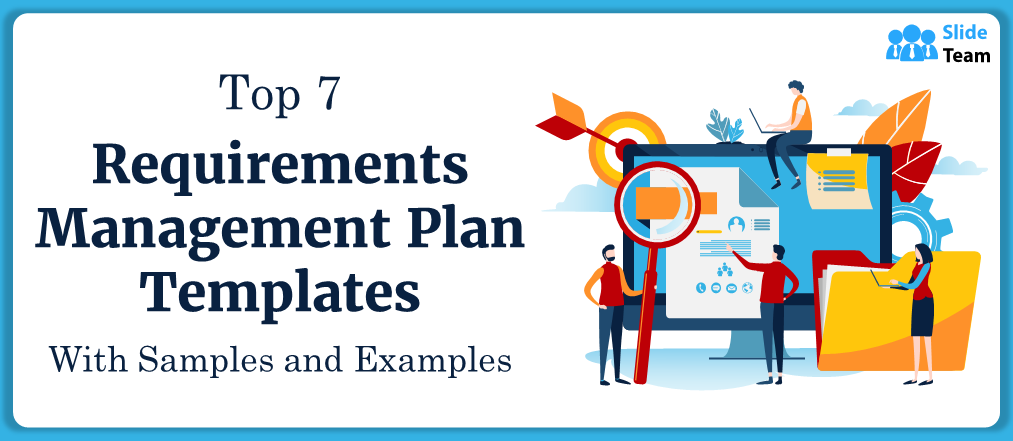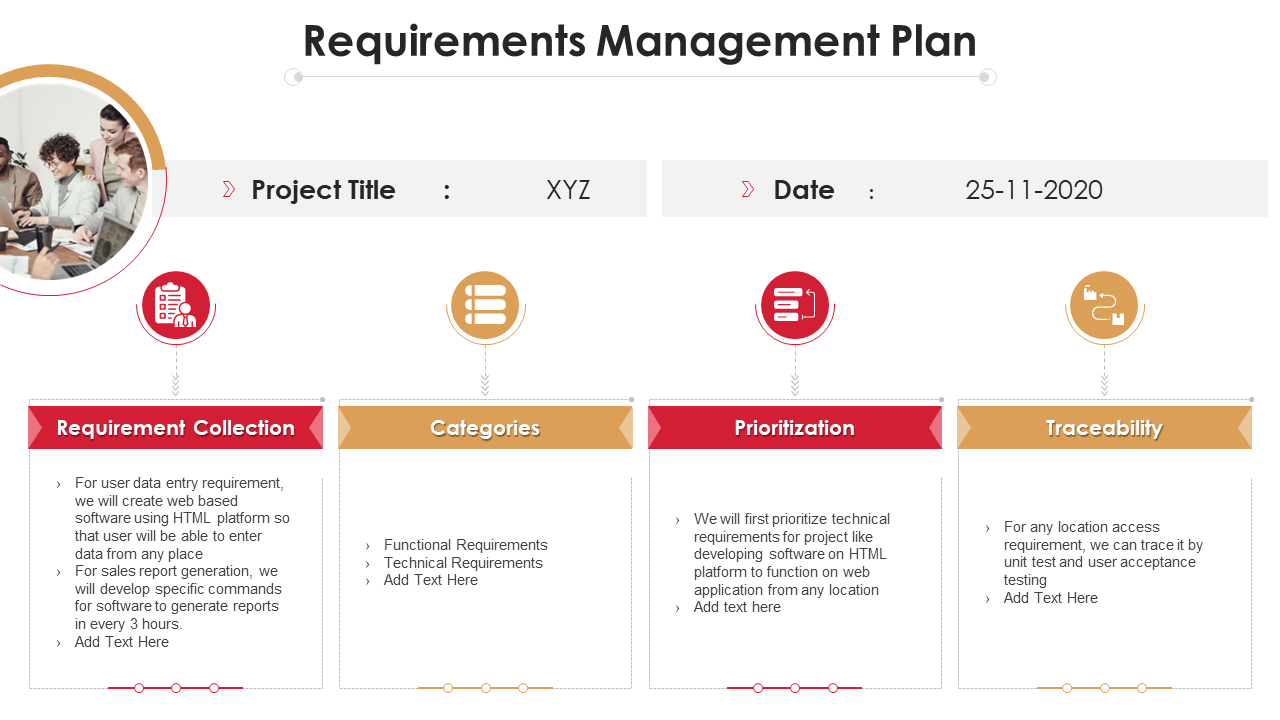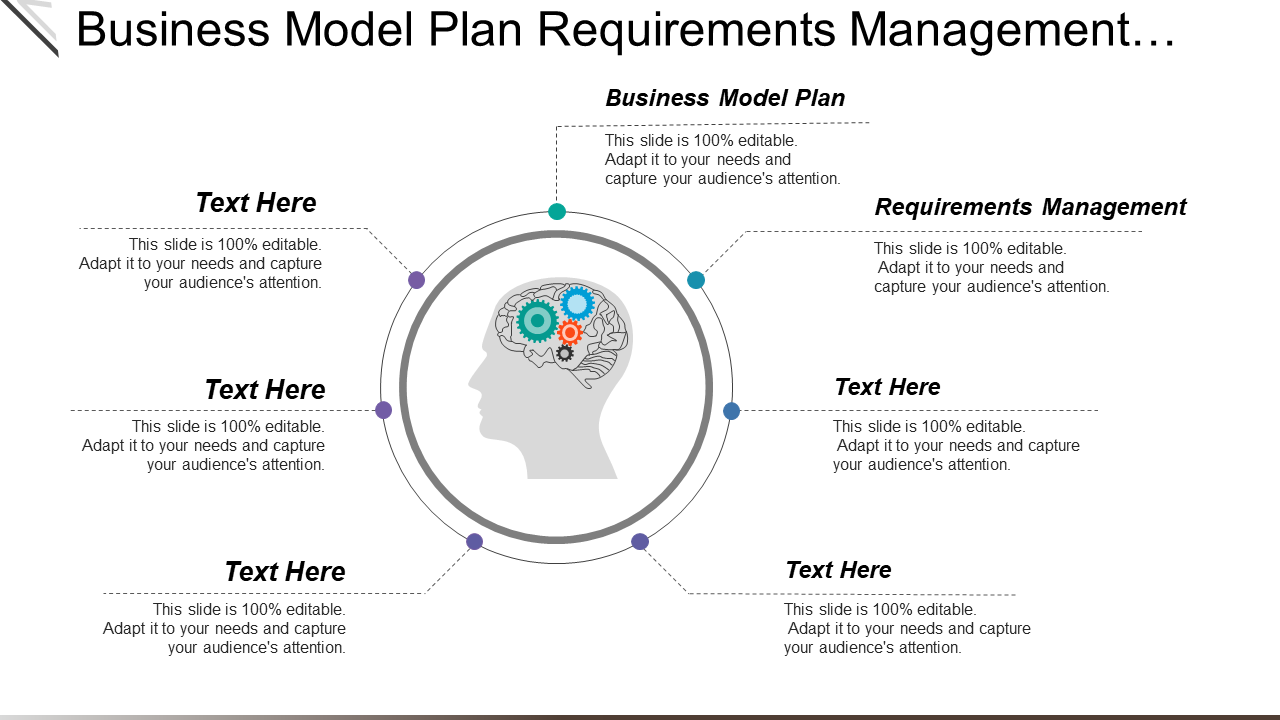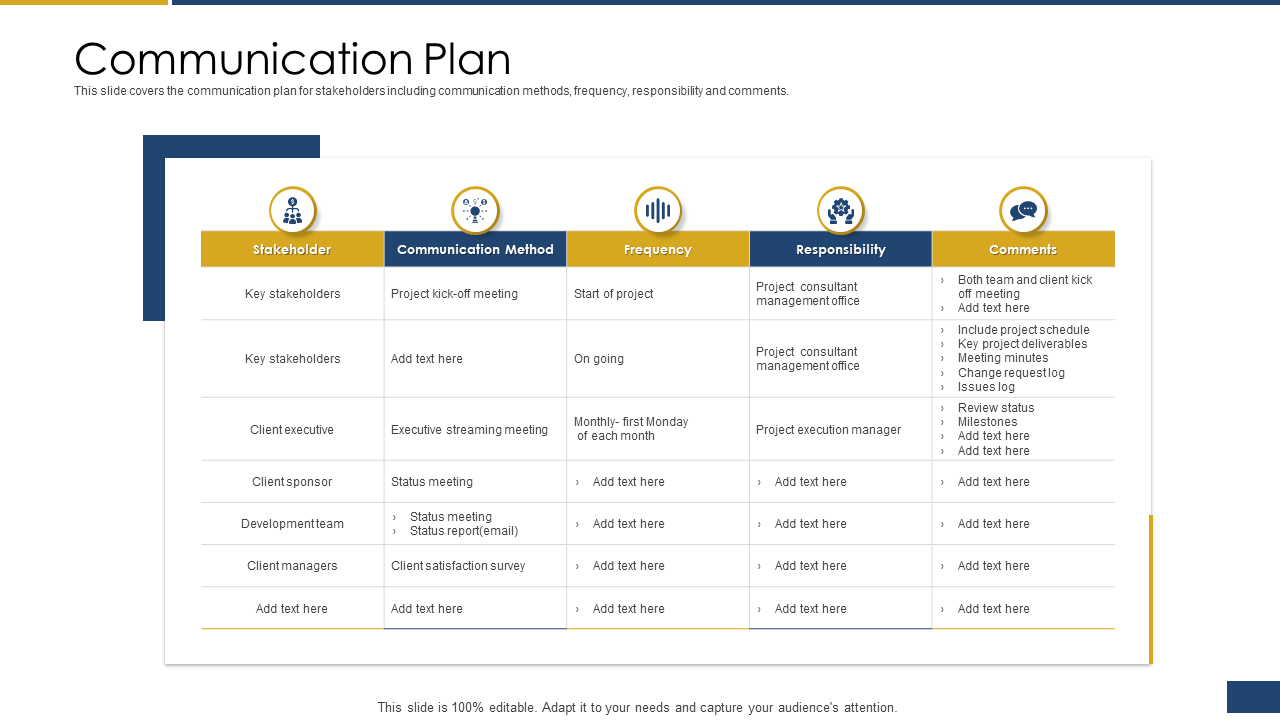Every project is pivoted around meeting some end requirements that are either requested by the stakeholders or align with the company's goals. Served in raw form, these project requirements need to be analyzed, documented, and monitored from time to time for an effective implementation. For this reason, your project team concerns itself with a Requirements Management Plan.
While project expectations can be vaguely defined sometimes, it's important to analyze them before spending millions of dollars on resources. Here's where a requirements sheet becomes important. To develop products and services with certain specifications, you must create a list mentioning clear and specific requirements. Once composed, a Requirements Management Plan Template must be circulated among all relevant team members to make the end product a reality.
With rigorous current state assessments and scenario analysis, project managers may need to reform and update these requirements to improve the quality of end products and services. Another reason to work on a sheet of requirements is to ensure planned activities follow with zero to minimum deviations in the budget vs. actual analysis.
Thus, an intelligent evaluation of requirements is the key to wooing your customers by creating products and services worth their investment. For this, Requirements Management Plan Templates must be put to use. But where can you find such expert PPT layouts that bring great returns for your business?
With SlideTeam's Requirements Management Plan Templates, keep up with the project expectations while claiming the title of a presentation professional. The 100% customizable nature of the templates provides you with the desired flexibility to edit your presentations while the content-ready slides give you the much-needed structure. We would really like you to try these now!
Template 1: Requirements Management Planning PowerPoint Presentation
Create a comprehensive report on requirements management planning starting from identifying issues to addressing them with a suitable product or service. Gather insights from surveys, analysis, and customer feedback to create an ideal sheet of specifications that your products and services should encompass. Represent insights as charts, sheets, and graphs and filter out the most desirable features. Plan your budget ahead of investing efforts and time and share this complete report with relevant stakeholders and the project team. Download now!
Template 2: Procurement Plan for Project Requirements Management Template
Suppose you are working on a construction project with certain specifications as requested in the plan. Utilize this content-ready project requirements management plan template to mention sources, due dates, departments placing requests for their procurement. Be it the landscape, furnishing, specialized equipment, etc, maintain and update this requirements’ sheet to stay ahead of constructing pleasing living and professional spaces. Grab it now!
Template 3: Requirements Management Plan for Project Analysis Template
Monitor the process of requirements management planning step by step with this PPT Layout. Begin with requirement collection, its categorization, prioritization and traceability as shown in this slide. Then move forward with approval, change control, communication, status reporting, and risk management. Share details of what each of these steps implies for your project and ensure your project is guided. Click on the download link below.
Template 4: Procurement Plan for Project Requirements Management
To ensure project milestones are achieved, it is important to analyze, track, verify, and procure requirements. Suppose the project you are working on revolves around developing a new website, an application, or software utility; gather and monitor the procurement of all utilities, such as design contracts, training materials, etc, for delivering a functional and purposeful end product or service. Add your company details along and update this requirements sheet regularly. Grab it now!
Template 5: Business Model Plan with Requirements Management Template
Create a business model with special attention to requirements management with this PPT Diagram. Mention all steps involved in creating a working business model plan so that aspects like timely completion, risk management, communication, and status updation, etc are ensured throughout the project. To use this PPT Design to the fullest, click on the download link below.
Template 6: Communication Plan Process for Requirements Management Template
Requirements Management is an on-going process that requires smooth communication, right from data collection, analysis, documentation, to making changes when needed. Streamline your project communication process with this requirements management plan template. Summon all the primary stakeholders involved, and mention their communication method, frequency, and responsibility in this tabular PPT Slide. Download this content-ready slide now!
Template 7: Organization of a Requirement Management Plan Template
If you want to implement a waterfall model for your IT project’s requirements management planning, do it with this content-ready PPT Template. Specify this linear model’s four key partitions, such as inception, elaboration, construction, and transition with this PPT Layout and support these with subsequent steps. List the elements of requirements traceability, IT section, and coordinated tasks to address the complete waterfall model for your project. Without ado, grab this PPT Template now.
Connect these Management Plan Templates to a real-time monitoring service and stay up-to-date on latest project requirements.
PS: Project communication is important at each and every step. Whether you want to tune in for updates, suggest upgrades, or evaluate progress, create a project communication plan that builds transparency and values time. Explore this blog replete with 15 best-in-class project communication plan templates ready to use now!
FAQs on Requirements Management Plan
What are the components of the requirements management plan?
The components of a requirements management plan typically include the following:
- Introduction: An overview of the purpose and scope of the requirements management plan.
- Requirements Process: A description of the process that will be used to elicit, analyze, specify, validate, and manage requirements throughout the project.
- Requirements Traceability: A method for tracing the requirements from their original source to the final product, ensuring that all requirements are met and documented.
- Requirements Prioritization: A method for prioritizing requirements, including criteria for what constitutes a high, medium, or low priority requirement.
- Requirements Approval Process: A description of the process for approving requirements, including who has the authority to approve or reject requirements and how requirements will be verified and validated.
- Requirements Change Control Process: A description of the process for managing changes to the requirements, including how changes will be initiated, reviewed, approved, and implemented.
- Requirements Communication Plan: A description of how requirements will be communicated to stakeholders, including the frequency and format of communication.
- Requirements Status Reporting: A description of how requirements status will be reported, including what information will be reported and how often.
- Requirements Risk Management: An assessment of the risks associated with the requirements and a plan for mitigating those risks.
- Conclusion: A summary of the key points of the requirements management plan and any additional information that may be relevant to the project.
What are the four steps for managing requirements?
The four steps for managing requirements are:
- Elicitation: This is the process of gathering and documenting the requirements from stakeholders, such as customers, end-users, and subject matter experts. During this step, the requirements are defined and captured in a format that is clear and concise.
- Analysis: In this step, the requirements are analyzed to ensure they are complete, consistent, and unambiguous. The requirements are also prioritized based on their importance and impact on the project.
- Specification: In this step, the requirements are refined and specified in greater detail. The requirements are also traced to ensure that they can be traced back to their source, and to support future change management processes.
- Validation: In this final step, the requirements are validated to ensure that they meet the needs of the stakeholders and that they are aligned with the project's objectives. The requirements are also tested and verified to ensure that they are achievable and that the resulting product or solution meets the needs of the stakeholders.
What are the 5 steps to create a management plan?
Creating a management plan typically involves the following five steps:
- Define the objectives: This may include identifying the goals and objectives of the project, the scope of the work, and the desired outcomes.
- Assess the current situation: This step involves reviewing data, conducting research, and gathering information to better understand the current state of the project.
- Develop strategies and action plans: This may include identifying specific tasks, assigning responsibilities, and determining a timeline for completion.
- Allocate resources: The next step is to assigning the necessary resources, including personnel, funding, and equipment, to ensure that the action plans can be implemented successfully. This step may also involve developing a budget and identifying potential risks.
- Implement and monitor the plan: This may include regularly reviewing the plan to ensure that it is on track, making adjustments as necessary, and tracking the results to measure success.
What is the purpose of the Requirement Management Plan?
The purpose of a requirement management plan (RMP) is to provide a framework for defining, documenting, and controlling the requirements of a project. It serves as a guide for ensuring that the requirements are clearly defined, agreed upon, and consistently tracked throughout the project's lifecycle. The RMP provides a structure for managing the requirements of the project and helps to minimize the risk of misunderstandings and scope creep.
The main objectives of a requirement management plan include:
- Define the requirements process
- Ensure stakeholder agreement
- Trace requirements
- Control changes
- Facilitate communication
What is waterfall technology in requirements management?
Waterfall technology is a traditional sequential methodology for software development. In the context of requirements management, it refers to a linear approach to the software development process, where each stage is completed before moving on to the next one. The stages in the waterfall model of requirements management are typically:
- Requirements Gathering: This is the first stage where the requirements for the software are gathered and documented. Requirements can come from various sources such as stakeholders, end-users, and subject matter experts.
- Analysis: In this stage, the requirements are analyzed to determine the feasibility of the project and to identify any potential issues.
- Design: In this stage, the system design is created based on the requirements gathered in the first stage.
- Implementation: This stage involves the actual development of the software, using the design created in the previous stage.
- Testing: Once the software has been developed, it undergoes testing to ensure that it meets the requirements and is free of any defects.
- Deployment: After the software has passed testing, it is deployed to production.
- Maintenance: Once the software is deployed, it enters the maintenance phase, where it is monitored and maintained to ensure that it continues to meet the needs of the stakeholders.
In the waterfall model, each stage must be completed before moving on to the next stage, and there is limited opportunity to make changes to the requirements once a stage has been completed. This model can be useful for projects with well-defined requirements, but it may not be suitable for projects with complex or rapidly changing requirements.





 Customer Reviews
Customer Reviews





















